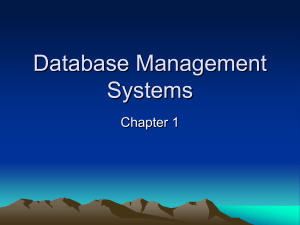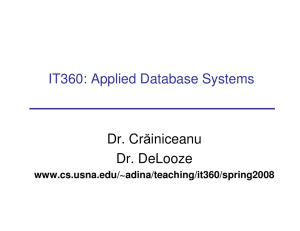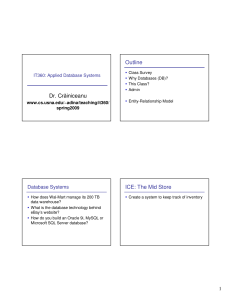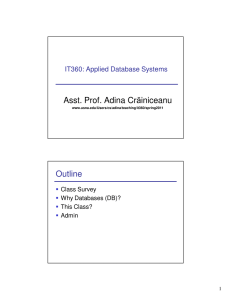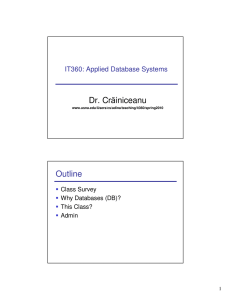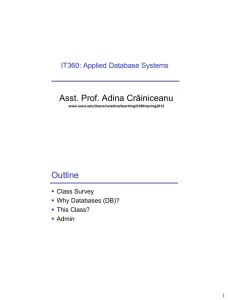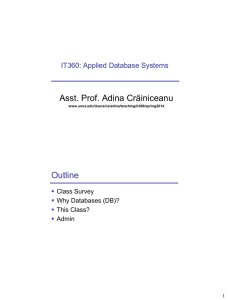Introduction to Database Management System Pertemuan 01 Matakuliah
advertisement
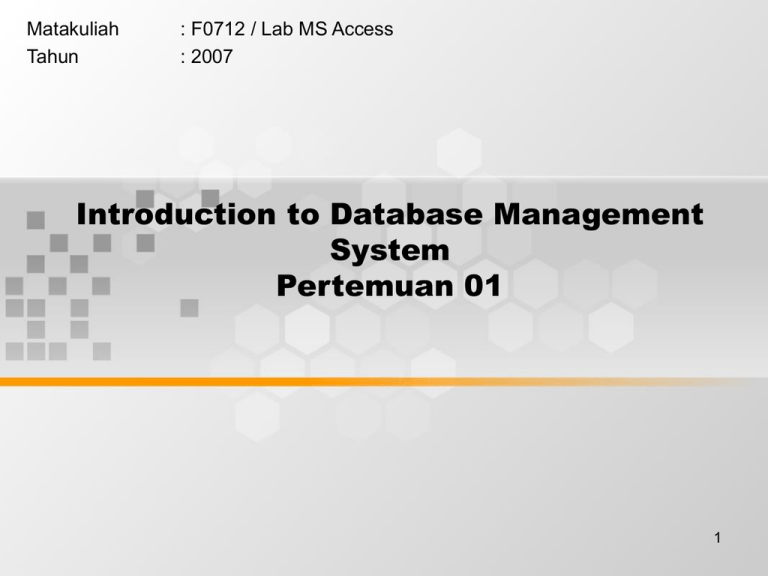
Matakuliah Tahun : F0712 / Lab MS Access : 2007 Introduction to Database Management System Pertemuan 01 1 Sejarah Singkat Database Era Years Important Products Predatabase Before 1970 File Managers Early Database 1970 - 1980 Emergence of relational model 1978 - 1985 ADABAS, System2000, Total, IDMS, IMS DB2, Oracle Microcomputer DBMS 1982 - 1992 products Object-oriented DBMS 1985 - 2000 Web Database 1995 - present XML and Web Service 1998 - present Remarks All data were stored in separate files. Data integration was very difficult. File Storage space was expensive and limited. First products to provide related tables, CODASYL DBTG, and hierarchical data models (DL/I) were prevalent. Early relational DBMS products had substantial inertia to overcome. In time, the advantages weighed out. dBase-II, R:base, Amazing !, Adatabse on a micro. All micro Paradox, Access DBMS products were eliminated by Microsoft Access in the early 1990s. Oracle ODBMS and Never caught on. Required relational database others to be converted. Too much work for perceived benefit. IIA/ASP, Apache/PHP, Stateless characteristic of HTTP was a problem and JAVA at first. Early applications were simple onestage transactions. Later, more complex logic developed. XML, SOAP, WSDL, XML provides tremendeous benefits to web UDDI and other based applications. Very important today. May standards replace relational databases. 2 Karakteristik Database (1) • A Note on Conventions Conventions will help to distinguish table names in explanations. Examples : STUDENT, Term, StudentNumber etc. • A Database has Data and Relationship 3 Karakteristik Database (2) • Databases Create Information Databases record facts and figures; they record data, that enables them to produce information. 4 Contoh – contoh Database • • • • (1) Single-User Database Applications. Multiuser Database Applications. E-Commerce Database Applications. Reporting and Data Mining Database Applications. 5 Contoh-contoh Database Application Example Users Number of Users Sales Contact Manager Salesperson Patient appointment (doctor, dentist) Medical Office Customer Resource Management (CRM) Sales, Marketing, or Customer service departments An entire organization Enterprise Resource Processing (ERP) E-commerce site Internet users Digital dashboard Senior managers Data mining Business analyst Typical Size 1 2.000 rows 15 to 50 100.000 rows 500 10 million rows 5000 10 million+ rows Possibly million 1 billion+ rows 500 100.000 rows 25 100.000 to millions+ (2) Remarks Products such as GoldMine and Act! Are database centric Vertical market software vendors incorporated databases into their software products. Major vendors such as Siebel and PeopleSoft build applications around the database. SAP uses a database as a central repository for ERP data. Drugstore.com has a database that grows at the rate of 20 million rows per day. Extraction, summaries, and consolidations of operational databases. Data are extracted, reformatted, cleaned, and filtered for use by statistical data mining tools. 6 Komponen Sistem Database (1) • Databases have three components : • Applications are computer programs that users interact with directly. Applications accept data from users, process it according to apllication-specific requirements. • SQL or Structured Query Language is an internationally recognized standard language that is understood by all commercial database management system products. 7 Komponen Sistem Database (2) • DBMS or Database Management System creates, process, and administers the database. A DBMS is large and complicated product and few organizations write their own DBMS program. Instead, DBMS products are licensed from vendors such as Microsoft, Oracle and IBM. • Figure 1-4, hal 8 • Figure 1-6, hal 9 8

